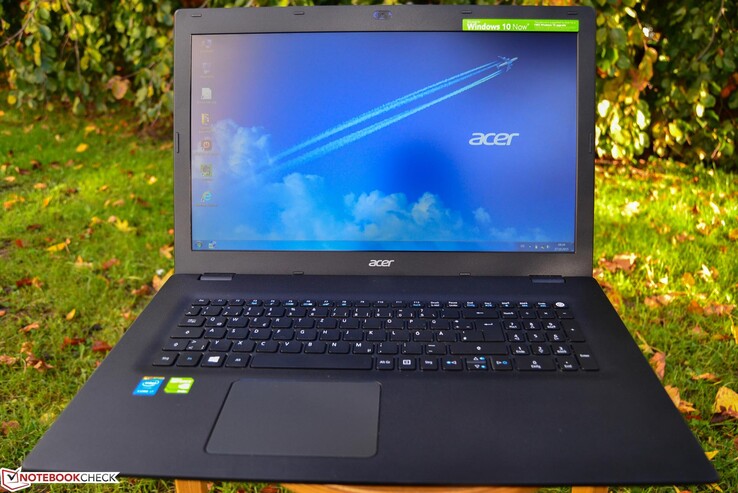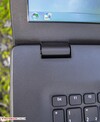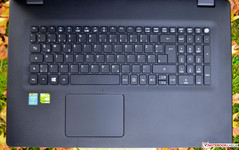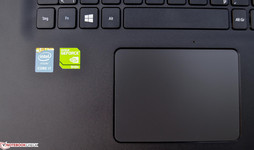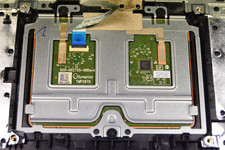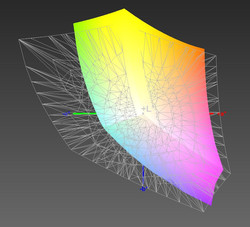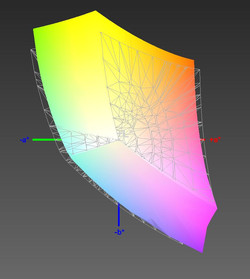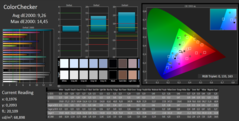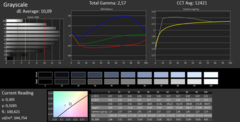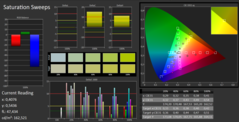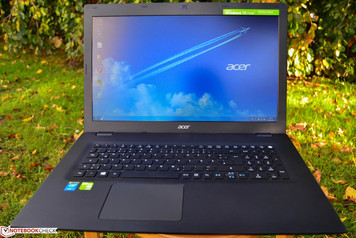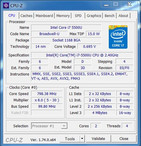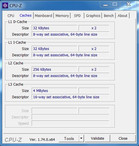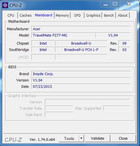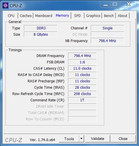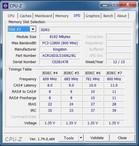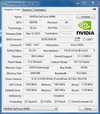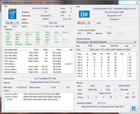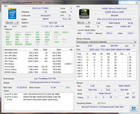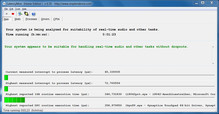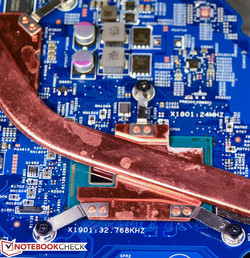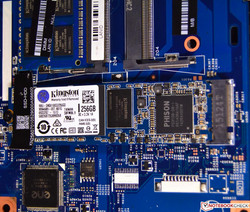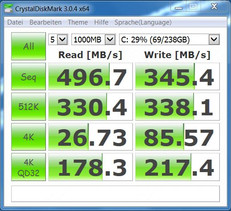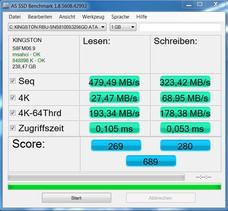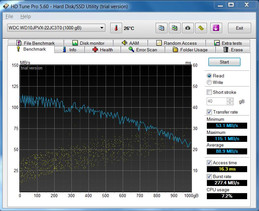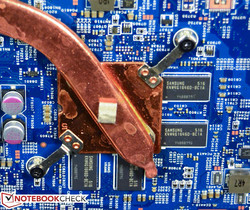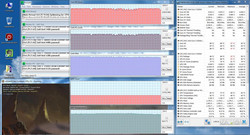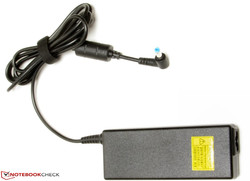Acer TravelMate P277-MG-7474 Notebook Review

For the original German review, see here.
The model that Acer Germany kindly provided us with wants to fuse performance and mobility. Actually, the processing power of the Intel Core i7-5500U with Hyperthreading, 8 GB of RAM (1 module = single-channel mode), 1 TB HDD and optical drive would clearly suffice for normal office use. The present configuration is lightning-fast thanks to the M.2 SATA SSD from Kingston. The allegedly new Nvidia GeForce 940M with just 2048 MB DDR3 VRAM transforms the laptop into a gaming suitable device. However, Nvidia has only increased the clock rates marginally compared with the former GeForce 840M.
Finding good and apt rivals is difficult because the most important features of an office device are its keyboard, touchpad, screen, emissions and battery life. Therefore, we selected HP's Pavilion 17-g013ng that is, however, based on a conventional hard drive. The same is true for Asus PU551JH Workstation presently the Notebookcheck Editor's Choice in 15.6-inch models. The lack of an SSD can be tolerated when seen as a pure office device.
Case
An eye-catching feature of the slip-proof, full-body plastic casing is the linen fabric looks on the lid's back. This pattern is also found on the laptop's underside. The display bezel and base's diamond-patterned upper side are fortunately made in the same black color as the rest of the casing. Both the fabric pattern on the lid's back and the diamond pattern defy fingerprints, and barely any marks were seen even after 2 weeks.
The relatively thick lid is not exceptionally stiff, but it is nevertheless pressure resistant. It can be opened easily with one hand, and yet it only rocks a very small amount when bumped. The hinges exhibit a very good build. We pressed the opened lid's back with 8 fingers to test the display's resistance. Although the display's lid dented, it was not enough to provoke distortions on the active screen. The base could be twisted by 3 mm (0.12 in) using moderate force, and mostly without a noise. We did not discover any irregular gaps or protruding edges. In total, the casing made a compelling impression on the tester, and it fits perfectly to the targeted office alignment. The input devices, such as keyboard and ClickPad, are impeccably incorporated at first glance. Unfortunately, the review sample's ClickPad was not fastened (screwed) properly, which considerably reduces the overall impression.
Connectivity
In short: Everything that is needed is present; special features, such as a DisplayPort or Thunderbolt, are not installed. Ethernet, 2x USB 3.0, HDMI, VGA, combo audio in/out 3.5 jack are on the left, keeping the right free of peripherals. Thanks to HDMI and the, admittedly, somewhat obsolete VGA port, it is possible to connect up to two monitors. It was a bit difficult to connect USB devices to the USB 3.0 ports at first since quite some force was needed to insert and remove the devices, but it became increasingly easier after a week of extensive usage. Both USB 2.0 ports on the right functioned without inordinate force. Copying large files on the internal SSD was no problem, and was consistent with the maximum speed of the external hard drive (approx. 100 MB/s, at USB 3.0).
The SD card reader is situated on the front. We tested its performance with our Toshiba Exceria Pro SDXC 64 GB UHS-II reference SD card. The maximum transfer rate was 80 MB/s for copying large data blocks. According to AS SSD, the card reader managed 36.7 MB/s read and 28.4 MB/s write. 35 to 42 MB/s can be expected with standard JPG image files. We recorded 27 MB/s for copying 250 images in our test.
The status LEDs on the front shine downward, and are only visible when reflecting their light on the table. That is very welcome in the evening because status LEDs can irritate during intensive office work. Both status LEDs in Acer's Aspire E5-772G (identically built casing) had the same color. One LED is blue and the other that indicates charging or low battery capacity shines orange in the TravelMate P277-MG-7474. The DC-in is in the rear right.
Communication
The TravelMate P277-MG-7474 can utilize either the 2.4 or 5 GHz wireless band thanks to a very high-quality Intel Dual Band Wireless-AC 7265. That is particularly beneficial in the city as well as in offices or apartment buildings where many 2.4 GHz Wi-Fi networks are usually active and disturb the transmission rate. The option of using the 5 GHz band has its advantage here.
The writer set up a personal test scenario in a reinforced concrete apartment building, connected to a 2.4 GHz band router that is additionally behind a 49-inch monitor hung on a wall. The writer closed all doors, and yet the connection remained stable with at least 2 reception bars in every corner of the apartment. The reception of 5 bars is outstanding in the garden (25 m/~27 yards in a straight line through a window from the router). Despite this intentionally chosen unfavorable test setup (installed router, reinforced concrete walls & multiple (12) 2.4 GHz band routers in the apartment building), the reception of the TravelMate P277-MG-7474 was convincing. Therefore, there should barely be any issues regardless whether at home with a good router or in an office building with a middling router.
Security
A Trusted Platform Module (TPM) is not integrated. Acer preloads its own "ProShield" software, which allows setting up system access via face recognition, for example.
Accessories
In addition to the compulsory power supply, the box only contained the equally compulsory user's manual and warranty notes.
Maintenance
Maintenance hatch? Not one in sight. Opening the device involves risking loss of warranty. The laptop can be opened as follows:
1. Release 20 screws on the underside
2. Turn the laptop right way up (keyboard, touchpad side)
3. Unclasp the plastic hooks that join the upper side and underside with a special tool or a credit card (carefully, they break easily)
4. Remove the base's upper side (carefully, separate touchpad and keyboard connection)
The user is then rewarded with access to Wi-Fi, HDD, battery and DVD drive. It would at least be worth a try to ask Acer directly for permission to open the device to preserve warranty claims.
The laptop would have to be disassembled even further to access the M.2 SATA SSD, RAM, processor or graphics.
Warranty
The statements about warranty period are contradictory. Acer Support asserts a 2-year warranty when the TravelMate is purchased in Germany (the result of an email inquiry by the writer to Acer Support). However, the warranty cards (warranty + ITW = International Traveler's Warranty) indicate a one-year warranty. This period starts on the date of purchase. Paragraph 4: "Limitations and Exclusions" (see here), explains what actions would lead to a loss of warranty.
Input Devices
Keyboard
We also find an island-style keyboard (chiclet keyboard) here. The function keys and the number pad keys are flat and one centimeter smaller in width than the other keys, which are lightly concave. Acer again integrates the power button in the keyboard's upper right. Apart from volume and screen brightness (arrow keys), everything is where it would be expected.
Typing is very pleasant and also quiet (personal subjective impression) thanks to a sufficient key drop, well-palpable pressure point and only lightly cushioned stroke. The writer did not discover any flaws in quality (clattering, yielding). The lack of a keyboard backlight can be criticized.
Touchpad
Not much good can be said about the touchpad, which is an agreeably sized ClickPad. The touch and cursor speed would have to be increased before responsiveness and accuracy can be rated as good. Vibrations were experienced that required opening the review sample and tightening the touchpad's screws. The ClickPad's quality as well as a crisp pressure point were fine after the repair. Subsequent to this optimization, Drag & drop functioned reliably and not even moist fingers were thwarted on the sleek surface that is touch-sensitive up to its edges.
Display
The models of the TravelMate P277 come in different configurations and with different screen resolutions. The cheapest device, the TravelMate P277-M-34K4 with a resolution of 1600x900 pixels, had a price tag of almost 600 Euros (~$636) at test time. We cannot say anything about the pros and cons at this point since no other screen versions were available for the test. However, for 17.3-inch screens, at least Full HD is recommended.
The matte, 17.3-inch TN LED screen in the TravelMate P277-MG-7474 has an aspect ratio of 16:9 and native resolution of 1920x1080 pixels (Full HD). It operates with an average brightness of 319 cd/m² (maximum: 339 cd/m²) - a very good rate that is clearly above the average of this category. The brightness (336 cd/m²) is also maintained in battery mode. We cannot complain about screen bleeding or clouding (white spots) on a completely black image (RGB 0,0,0) at least when we sat in an ideal position in front of the display. The TN LED scores very well in the brightness comparison with its rivals, and achieved second place directly behind the "only" 15.6-inch Asus PU551JH Workstation. A good outcome. While the HP's Pavilion 17-g013ng and Acer's Aspire V17 Nitro VN7-792G-55SF screens are very good, and also better in terms of color space coverage, they only manage third place because their brightness drops to 266 cd/m² and 277 cd/m² respectively in battery mode, which is not enough for outdoor use (sun, not direct sunlight).
| |||||||||||||||||||||||||
Brightness Distribution: 84 %
Center on Battery: 336 cd/m²
Contrast: 781:1 (Black: 0.43 cd/m²)
ΔE ColorChecker Calman: 9.26 | ∀{0.5-29.43 Ø4.78}
ΔE Greyscale Calman: 10.09 | ∀{0.09-98 Ø5}
92% sRGB (Argyll 1.6.3 3D)
60% AdobeRGB 1998 (Argyll 1.6.3 3D)
67.3% AdobeRGB 1998 (Argyll 3D)
92.1% sRGB (Argyll 3D)
69.9% Display P3 (Argyll 3D)
Gamma: 2.57
CCT: 12421 K
| Acer TravelMate P277-MG-7474 GeForce 940M, 5500U, Kingston RBU-SNS8100S3256GD | Acer Aspire V Nitro 7-791G-70TW GeForce GTX 960M, 4720HQ, Kingston RBU-SNS8100S3256GD | Asus PU551JH Quadro K1100M, 4210M, Hitachi Travelstar Z7K500 HTS725050A7E630 | HP Pavilion 17-g013ng GeForce 940M, 5500U, Seagate ST1000LM014 Solid State Hybrid Drive | Acer Aspire V Nitro VN7-792G-55SF GeForce 945M, 6300HQ, Toshiba MQ02ABD100H | Acer Aspire E5-772G-70VP GeForce 940M, 5500U, Kingston RBU-SNS8100S3128GD | Acer Travelmate P276-MG-56FU GeForce 840M, 4210U, WDC Scorpio Blue WD10JPVX-22JC3T0 | |
|---|---|---|---|---|---|---|---|
| Display | -3% | 1% | 1% | 1% | -0% | -2% | |
| Display P3 Coverage (%) | 69.9 | 70.1 0% | 67.1 -4% | 66.5 -5% | 68 -3% | 69.4 -1% | 65.9 -6% |
| sRGB Coverage (%) | 92.1 | 87.5 -5% | 96.5 5% | 97.1 5% | 94.6 3% | 91.9 0% | 92.9 1% |
| AdobeRGB 1998 Coverage (%) | 67.3 | 63.9 -5% | 69.2 3% | 68.4 2% | 68.6 2% | 67.3 0% | 67.5 0% |
| Response Times | 5% | ||||||
| Response Time Grey 50% / Grey 80% * (ms) | 27 ? | 36 ? -33% | |||||
| Response Time Black / White * (ms) | 28 ? | 16 ? 43% | |||||
| PWM Frequency (Hz) | 100 | ||||||
| Screen | 9% | 14% | 19% | 20% | -16% | -8% | |
| Brightness middle (cd/m²) | 336 | 347 3% | 337 0% | 321 -4% | 277 -18% | 243 -28% | 345 3% |
| Brightness (cd/m²) | 319 | 326 2% | 318 0% | 308 -3% | 261 -18% | 284 -11% | 317 -1% |
| Brightness Distribution (%) | 84 | 90 7% | 88 5% | 89 6% | 88 5% | 79 -6% | 79 -6% |
| Black Level * (cd/m²) | 0.43 | 0.409 5% | 0.39 9% | 0.32 26% | 0.26 40% | 0.45 -5% | 0.55 -28% |
| Contrast (:1) | 781 | 848 9% | 864 11% | 1003 28% | 1065 36% | 540 -31% | 627 -20% |
| Colorchecker dE 2000 * | 9.26 | 6.81 26% | 4.5 51% | 3.79 59% | 3.49 62% | 12.04 -30% | 10.05 -9% |
| Greyscale dE 2000 * | 10.09 | 7.27 28% | 5.94 41% | 4.75 53% | 3.27 68% | 13.25 -31% | 10.18 -1% |
| Gamma | 2.57 86% | 2.4 92% | 2.32 95% | 2.37 93% | 2.35 94% | 2.6 85% | 2.72 81% |
| CCT | 12421 52% | 7546 86% | 6883 94% | 7130 91% | 6801 96% | 14950 43% | 12180 53% |
| Color Space (Percent of AdobeRGB 1998) (%) | 60 | 57 -5% | 62 3% | 62 3% | 61.5 3% | 60 0% | 60 0% |
| Color Space (Percent of sRGB) (%) | 92 | 96 4% | 97 5% | 94.6 3% | 92 0% | ||
| Total Average (Program / Settings) | 3% /
6% | 8% /
11% | 10% /
15% | 9% /
14% | -8% /
-12% | -5% /
-6% |
* ... smaller is better
The average maximum screen brightness that Acer's TravelMate P277-MG-7474 achieves is 319 cd/m², which provides good preconditions for problem-free outdoor use. The illumination of 84% is solid and makes a homogeneous brightness distribution impression subjectively. The screen brightness can be fine-tuned in 9 steps up to the maximum setting. We measured 153 cd/m² at setting 4, which we also used for our battery tests. The black level of 0.43 cd/m² alongside the maximum brightness results in a contrast of 781:1. The reproducible colors cover 92% of the sRGB color space. That is a very good rate for a laptop screen. By comparison: The ViewSonic VP2780-4k desktop monitor made for video and photography applications achieves 97% of the sRGB color space. Only RGB LED displays presently offer noticeably more colors. When all screen aspects are added up (brightness, battery, black level, contrast, color space coverage), Acer's TravelMate P277-MG-7474 takes third place close behind Acer's Aspire V Nitro 7-791G and the 15.6-inch Asus' PU551JH Workstation. HP's Pavilion 17-g013ng and Acer's Aspire V17 Nitro VN7-792G-55SF are fourth place again, because the low screen brightness is not enough for outdoor use (sun, not direct sunlight).
Good TN screens have improved considerably in the past years, and we are dealing with one of the best in this TN category. The colors look vivid, and they are largely maintained when looking from the side. Even brightness and contrast loss are within limits. Vertically shifted viewing angles are still a bigger problem, but the usual reproduction errors are seen later and are not as intensive as in older or inferior TN screens.
Performance
The very efficient, 15-watt Intel Core i7-5500U dual-core processor can easily cope with today's office routine. Even image editing via Photoshop is unconditionally possible. Therefore, this processor or also an Intel Core i5-5200U (should the price be more interesting) is first choice for an office laptop. If the user can accept some compromises, some current 3D games (1366x768, no AA, medium details) could be played with Nvidia's GeForce 940M. Nvidia's GPU is a perfect match for the dual-core CPU (4 threads). Users who occasionally edit videos will manage well with the review sample. The combination of SSD (for operating system, installed software & games) and HDD (for documents, music, videos, etc.) earns praise. The DVD burner rounds off the laptop.
A stronger CPU, such as Intel's Core i7-4720HQ or Intel's Core i7-6820HQ, (4 cores, 8 threads) + RAM (8 GB dual-channel) would be recommended for more intensive color corrections (saturation, white balance) with subsequent video rendering. Acer's Aspire V Nitro 7-791G is used as a reference point in the chart below to illustrate the performance gain in this category. Unfortunately, this just six- month-old model is no longer available at test time; Acer's Aspire VN7-791G-72Q4 for 1300 Euros (~$1377) features a similar configuration.
Processor
Intel's Core i7-5500U dual-core processor (Broadwell) belongs to the frugal processors with its TDP of 15 watts. It nevertheless has enough power (see Performance). The Broadwell processing core operates at a base speed of 2.4 GHz, which can be boosted to 2.9 GHz (two cores) and 3 GHz (one core) via Turbo. The Turbo is fully utilized in both AC and battery mode. Intel's Core i7-5500U surpasses its Intel Core i7-4500U precursor by as much as 15% in the performed tests. The advantage in multithread applications is higher, which is due to the slightly higher operating speeds and the improved Broadwell architecture.
We would like to point out that the i7-5500U processor is "only" a dual-core processor. The only difference of this dual-core processor to Intel Core i5-5200U is its higher clock and the 1024 KB larger L3 cache. The large casing of our Acer P277-MG-7474 would have also allowed installing a quad-core with a TDP higher than 15 watts.
Minor throttling was only observed in unrealistic scenarios, such as simultaneously running Prime95 + FurMark; more about that under Temperature. The just received Acer Aspire V 17 Nitro VN7-792G-55SF offers Skylake architecture in the form of Intel's Core i5-6300HQ (45 watts, 4 cores, 4 threads, no Hyperthreading), and places itself before Intel's Core i7-5500U (15 watts) with a roughly 50% higher processor performance. The "performance per watt" crown clearly goes to Intel's Core i7-5500U in the review sample. Both Asus' PI551JH Workstation and HP's Pavilion 17-g013ng are on par with our review sample in terms of processor performance. Asus installs an Intel Core i5-4210M (37 watts).
| Acer TravelMate P277-MG-7474 GeForce 940M, 5500U, Kingston RBU-SNS8100S3256GD | Acer Aspire V Nitro 7-791G-70TW GeForce GTX 960M, 4720HQ, Kingston RBU-SNS8100S3256GD | Asus PU551JH Quadro K1100M, 4210M, Hitachi Travelstar Z7K500 HTS725050A7E630 | HP Pavilion 17-g013ng GeForce 940M, 5500U, Seagate ST1000LM014 Solid State Hybrid Drive | Acer Aspire V Nitro VN7-792G-55SF GeForce 945M, 6300HQ, Toshiba MQ02ABD100H | Acer Aspire E5-772G-70VP GeForce 940M, 5500U, Kingston RBU-SNS8100S3128GD | Acer Travelmate P276-MG-56FU GeForce 840M, 4210U, WDC Scorpio Blue WD10JPVX-22JC3T0 | |
|---|---|---|---|---|---|---|---|
| Cinebench R15 | 61% | -2% | -3% | 33% | -3% | -23% | |
| CPU Single 64Bit (Points) | 123 | 133 8% | 119 -3% | 122 -1% | 136 11% | 121 -2% | 99 -20% |
| CPU Multi 64Bit (Points) | 302 | 643 113% | 302 0% | 290 -4% | 468 55% | 293 -3% | 222 -26% |
| Cinebench R11.5 | 48% | 2% | -1% | 37% | -2% | -22% | |
| CPU Single 64Bit (Points) | 1.38 | 1.13 -18% | 1.39 1% | 1.41 2% | 1.49 8% | 1.37 -1% | 1.16 -16% |
| CPU Multi 64Bit (Points) | 3.29 | 7.03 114% | 3.34 2% | 3.18 -3% | 5.42 65% | 3.23 -2% | 2.39 -27% |
| Cinebench R10 | 54% | -4% | -2% | 37% | -1% | -22% | |
| Rendering Single 32Bit (Points) | 4592 | 5200 13% | 4276 -7% | 4632 1% | 5026 9% | 4589 0% | 3669 -20% |
| Rendering Multiple CPUs 32Bit (Points) | 10140 | 19788 95% | 10082 -1% | 9622 -5% | 16609 64% | 9942 -2% | 7707 -24% |
| Total Average (Program / Settings) | 54% /
54% | -1% /
-1% | -2% /
-2% | 36% /
35% | -2% /
-2% | -22% /
-22% |
System Performance
It is primarily owed to the SSD that nothing stands in the way of very smooth handling as well as fast program and operating system starts. Intensive multitasking with multiple Internet Explorer 11 tabs and programs running in the background did not slow down Acer's device. PCMark 7 and 8, which also include the graphics card, RAM and, above all, the storage device's performance in addition to the processor's performance, confirm our review sample's high system performance in the overall comparison.
Compared with the review sample, Acer's P276-MG-56FU, Asus' PU551JH Workstation and HP's Pavilion 17-g013ng clearly lag behind in PCMark 7 and 8 because they do not have an SSD. Even Acer's Aspire V17 Nitro VN7-792G-55SF falls behind by 8% despite its 45-watt CPU due to the lack of an SSD. With an SSD, the outcomes of the named rivals would be on the same, and the Nitro even on a higher level. Acer's Aspire E5-772G scores 16% better in PCMark 8 because our Acer TravelMate P277-MG-7474 review sample does not sport two RAM modules which excludes dual-channel mode. Acer's Aspire V Nitro 7-791G takes the first place thanks to its 47-watt CPU (4 cores, 8 threads) alongside the SSD.
| Acer TravelMate P277-MG-7474 GeForce 940M, 5500U, Kingston RBU-SNS8100S3256GD | Acer Aspire V Nitro 7-791G-70TW GeForce GTX 960M, 4720HQ, Kingston RBU-SNS8100S3256GD | Asus PU551JH Quadro K1100M, 4210M, Hitachi Travelstar Z7K500 HTS725050A7E630 | HP Pavilion 17-g013ng GeForce 940M, 5500U, Seagate ST1000LM014 Solid State Hybrid Drive | Acer Aspire V Nitro VN7-792G-55SF GeForce 945M, 6300HQ, Toshiba MQ02ABD100H | Acer Aspire E5-772G-70VP GeForce 940M, 5500U, Kingston RBU-SNS8100S3128GD | Acer Travelmate P276-MG-56FU GeForce 840M, 4210U, WDC Scorpio Blue WD10JPVX-22JC3T0 | |
|---|---|---|---|---|---|---|---|
| PCMark 7 | 23% | -43% | -37% | -8% | 16% | -54% | |
| Score (Points) | 4394 | 5669 29% | 2905 -34% | 3104 -29% | 4633 5% | 5254 20% | 2269 -48% |
| Creativity (Points) | 8071 | 10091 25% | 5440 -33% | 5952 -26% | 7737 -4% | 9869 22% | 4497 -44% |
| Productivity (Points) | 3853 | 4753 23% | 1751 -55% | 2082 -46% | 3342 -13% | 4319 12% | 1340 -65% |
| Lightweight (Points) | 4848 | 5486 13% | 2487 -49% | 2638 -46% | 3806 -21% | 5292 9% | 2003 -59% |
| PCMark 8 | -23% | 5% | 10% | 8% | -15% | ||
| Work Score Accelerated v2 (Points) | 4296 | 3311 -23% | 4251 -1% | 4483 4% | 4444 3% | 3604 -16% | |
| Home Score Accelerated v2 (Points) | 3053 | 2343 -23% | 3359 10% | 3524 15% | 3429 12% | 2658 -13% | |
| Total Average (Program / Settings) | 23% /
23% | -33% /
-36% | -16% /
-23% | 1% /
-2% | 12% /
13% | -35% /
-41% |
| PCMark 7 Score | 4394 points | |
| PCMark 8 Home Score Accelerated v2 | 3053 points | |
| PCMark 8 Work Score Accelerated v2 | 4296 points | |
Help | ||
Storage Device
It is pleasing that our review sample is furnished with an SSD and HDD ex-factory (only the dual-channel RAM kit is not included). The operating system, programs and games are installed on the SSD, which makes them interesting in our benchmarks. CrystalDiskMark recorded read rates of 496.7 MB/s (+/- 15 MB/s) and write rates of 345.4 MB/s (+/- 1-10 MB/s) from our P277-MG-7474 review sample. CrystalDiskMark and AS SSD scores vary by +/- 5-20 MB/s in all sectors. These fluctuations decrease considerably after optimizations (+/- 1-10 MB/s), such as Prefetch, Superfetch, TRIM, AHCI & Over Provisioning. The comparison with the Samsung 850 Evo 250 GB M.2 SATA in Schenker's XMG A706 review sample is interesting. This SSD doubtlessly has a higher performance than the Kingston RBU-SNS8100S3256GD 256 GB M.2 SATA installed in the review sample.
In a nutshell: Acer has solved the storage problem too well. While a 128 GB SSD would have also been sufficient for office work, the GT 940M GPU is insufficient for demanding titles like "GTA V" (60 GB).
The advantages of an SSD over an HDD are especially interesting for private users (not for the server sector). Everyone who has one will never want to be without again. Compulsory optimizations for SSDs are disabling Prefetch and Superfetch, enabling TRIM & AHCI mode as well as Over Provisioning. That reduces writing accesses, which considerably increases the lifespan and helps keep the read performance stable. Over Provisioning helps keep the SSD's write speed consistent as it is increasingly filled. Before and after test with the review sample including the Kingston RBU-SNS8100S3256GD illustrate this very clearly.
| Acer TravelMate P277-MG-7474 GeForce 940M, 5500U, Kingston RBU-SNS8100S3256GD | Acer Aspire V Nitro 7-791G-70TW GeForce GTX 960M, 4720HQ, Kingston RBU-SNS8100S3256GD | Acer Aspire E5-772G-70VP GeForce 940M, 5500U, Kingston RBU-SNS8100S3128GD | Schenker XMG A706 GeForce GTX 960M, 6700HQ, Samsung SSD 850 EVO M.2 250 GB | |
|---|---|---|---|---|
| CrystalDiskMark 3.0 | -0% | 4% | 34% | |
| Read Seq (MB/s) | 496.7 | 498.1 0% | 515 4% | 506 2% |
| Write Seq (MB/s) | 345.4 | 351.2 2% | 343.2 -1% | 448.9 30% |
| Read 512 (MB/s) | 330.4 | 337.1 2% | 341.1 3% | 422.9 28% |
| Write 512 (MB/s) | 338.1 | 351.6 4% | 337.2 0% | 380.7 13% |
| Read 4k (MB/s) | 26.73 | 24.72 -8% | 31.24 17% | 38.91 46% |
| Write 4k (MB/s) | 85.6 | 71.3 -17% | 86.6 1% | 90.4 6% |
| Read 4k QD32 (MB/s) | 178.3 | 179.9 1% | 178.5 0% | 362 103% |
| Write 4k QD32 (MB/s) | 217.4 | 250 15% | 242.4 11% | 311.4 43% |
Graphics Card
Nvidia again does some model name mimicry, and presents the same GM108 chip (Maxwell) with 384 Shader units and a 64-bit interface for a DDR3 RAM that operates in the older, marginally lower clocked GeForce 840M with the GeForce 940M launched in March this year. Consequently, there is no significant performance difference between the 4 laptops in the test based on either the 840M or 940M. Nvidia states a base clock of 1072 that can be boosted up to 1176 MHz via Turbo for the GeForce 940M. Acer follows these specifications exactly. The storage clock of the 2048 MB DDR3 VRAM is 2002 MHz.
Based on the usual 3DMarks, Nvidia's GeForce 940M is over twice as fast as the CPU-integrated, considerably more frugal Intel HD 5500. The latter takes care of less performance-driven (2D) graphic calculations and unloads the battery via Optimus Technology also in our review sample. The 3DMark Cloud Gate standard score only dropped 3% to 6380 points in battery mode. AMD's counterpart for Nvidia's GeForce 940M is the marginally weaker Radeon R7 M260X.
Nvidia's GeForce 960M with a 2048 MB GGDR5 VRAM installed in Acer's Aspire V Nitro 7-791G is considerably stronger. A similarly configured model is Acer's Aspire VN7-791G-72Q4 for 1300 Euros (~$1377) at test time.
| 3DMark 11 Performance | 2609 points | |
| 3DMark Ice Storm Standard Score | 36334 points | |
| 3DMark Cloud Gate Standard Score | 6577 points | |
| 3DMark Fire Strike Score | 1460 points | |
Help | ||
Gaming Performance
When up-to-date 3D games are planned, the user will usually have to be satisfied with low to medium settings and the 1366x768 pixels in most cases. Higher reproduction quality is possible in game like "Sims 4", "StarCraft II", "Counterstrike GO", the annual release of the "FIFA" editions, and the popular "Dota 2". Since models without a dedicated graphics card exist, buyers will have to decide whether the surcharge for the extra power is worthwhile.
| Watch Dogs | |
| 1366x768 Medium Overall Quality, Medium Textures (sort by value) | |
| Acer TravelMate P277-MG-7474 | |
| Acer Aspire V Nitro 7-791G-70TW | |
| 1920x1080 High Overall Quality, High Textures AA:2x MS (sort by value) | |
| Acer TravelMate P277-MG-7474 | |
| Acer Aspire V Nitro 7-791G-70TW | |
| Dirt Rally | |
| 1366x768 Medium Preset (sort by value) | |
| Acer TravelMate P277-MG-7474 | |
| HP Pavilion 17-g013ng | |
| 1920x1080 High Preset (sort by value) | |
| Acer TravelMate P277-MG-7474 | |
| HP Pavilion 17-g013ng | |
| low | med. | high | ultra | |
|---|---|---|---|---|
| BioShock Infinite (2013) | 90.4 | 52.2 | 42.5 | 14.54 |
| Watch Dogs (2014) | 45.7 | 30.3 | 9.2 | |
| Dirt Rally (2015) | 139.9 | 40.14 | 20.68 | 12.82 |
Emissions
System Noise
The fan in Acer's TravelMate P277-MG-7474 was active even while idling (system cooling policy: active), but could hardly be discerned from the usual ambient noises even at close range. The speed increased after enabling Prime95, and a subtle noise was audible from a distance of approximately two meters (~6 feet). Waste heat production climbed when the GPU stress test FurMark was added, and the noise became perceptibly louder. However, it remained docile and not distracting.
The new Acer Aspire V17 Nitro VN7-792G-55SF is fortunately quiet as a whisper, and humbled all other devices. The idle noise emissions of our other laptops in the test are roughly on par (32 - 35 dB(A)). Only the idle noise level should be reached in normal office routine. However, the louder level will not be distracting when playing a game or watching a video due to the background music.
| Acer TravelMate P277-MG-7474 GeForce 940M, 5500U, Kingston RBU-SNS8100S3256GD | Acer Aspire V Nitro 7-791G-70TW GeForce GTX 960M, 4720HQ, Kingston RBU-SNS8100S3256GD | Asus PU551JH Quadro K1100M, 4210M, Hitachi Travelstar Z7K500 HTS725050A7E630 | HP Pavilion 17-g013ng GeForce 940M, 5500U, Seagate ST1000LM014 Solid State Hybrid Drive | Acer Aspire V Nitro VN7-792G-55SF GeForce 945M, 6300HQ, Toshiba MQ02ABD100H | Acer Aspire E5-772G-70VP GeForce 940M, 5500U, Kingston RBU-SNS8100S3128GD | Acer Travelmate P276-MG-56FU GeForce 840M, 4210U, WDC Scorpio Blue WD10JPVX-22JC3T0 | |
|---|---|---|---|---|---|---|---|
| Noise | -2% | 9% | -4% | 12% | 4% | 4% | |
| Idle Minimum * (dB) | 33.5 | 29.6 12% | 29.1 13% | 32.7 2% | 30.1 10% | 32 4% | 33.7 -1% |
| Idle Average * (dB) | 33.5 | 32.1 4% | 31.9 5% | 33.3 1% | 30.1 10% | 32.3 4% | 33.9 -1% |
| Idle Maximum * (dB) | 33.6 | 35.4 -5% | 31.9 5% | 34 -1% | 30.9 8% | 32.6 3% | 33.9 -1% |
| Load Average * (dB) | 43.3 | 47.3 -9% | 36.4 16% | 45.6 -5% | 33.6 22% | 41.2 5% | 37.6 13% |
| Load Maximum * (dB) | 43.6 | 48.1 -10% | 41.6 5% | 50.6 -16% | 38.6 11% | 41.6 5% | 40 8% |
* ... smaller is better
Noise level
| Idle |
| 33.5 / 33.5 / 33.6 dB(A) |
| HDD |
| 33.5 dB(A) |
| DVD |
| 36.9 / dB(A) |
| Load |
| 43.3 / 43.6 dB(A) |
 | ||
30 dB silent 40 dB(A) audible 50 dB(A) loud |
||
min: | ||
Temperature
The graphics core in the Acer TravelMate P277-MG-7474 review sample performed the stress test (Prime95 Large FFTs and FurMark run for at least one hour) at full speed in AC mode, and at 900-970 MHz in battery mode. The processor operates at 2.2 - 2.7 GHz in both AC and battery mode. The maximum Turbo of 2.9 GHz (multithread clock) could not be maintained due to the high inner temperatures of 97 degrees Celsius (206.6 Fahrenheit).
Outcome: Throttling yes, but only when Prime95 + FurMark run simultaneously. The subsequently performed 3DMark 11 achieved the full score after the stress test, which excludes throttling. The temperatures did not reach any critical rates in routine use or during games, and throttling was not observed in either AC or battery mode.
In the Prime95 stress test (without FurMark), the processor operated at its maximum multithread clock of 2.9 GHz in both AC and battery mode. The GPU clocked at full speed (1176 MHz) in both AC and battery mode during the FurMark stress test (without Prime95).
The review sample does not struggle with heat issues at least from its outside. We measured a maximum temperature of 47.4 degrees Celsius (117.32 Fahrenheit) on the casing during the stress test (Prime95 + FurMark). It was considerably warmer inside with up to 97 degrees Celsius (206.6 Fahrenheit). The temperatures of some rivals are also very high, but even the hot devices (Acer Aspire E5-772G & Acer Aspire V Nitro 7-791G) performed 3DMark 11 at full speed. The outcome: There is absolutely no reason for concern as long as the user does not play games or perform stress tests with the device on the lap. Details about the temperatures can be found under the following links: Acer TravelMate P276-MG-56FU, Acer Aspire E5-772G, Acer Aspire V Nitro 7-791G, Acer Aspire V17 Nitro VN7-792G-55SF, HP Pavilion 17-g013ng, Asus PU551JH Workstation.
(+) The maximum temperature on the upper side is 36.2 °C / 97 F, compared to the average of 34.3 °C / 94 F, ranging from 21.2 to 62.5 °C for the class Office.
(-) The bottom heats up to a maximum of 47.4 °C / 117 F, compared to the average of 36.8 °C / 98 F
(+) In idle usage, the average temperature for the upper side is 24.6 °C / 76 F, compared to the device average of 29.5 °C / 85 F.
(+) The palmrests and touchpad are cooler than skin temperature with a maximum of 31.8 °C / 89.2 F and are therefore cool to the touch.
(-) The average temperature of the palmrest area of similar devices was 27.6 °C / 81.7 F (-4.2 °C / -7.5 F).
Speakers
When disregarding the absolutely non-existent bass, both downward-radiating speakers do a good job for laptop conditions. Dialog in videos sound rich and natural. The maximum volume is sufficient for rooms up to 20 m². The sound is clear and mostly without distortions (an exception: Enya - "May It Be"), and does not annoy with irritating volume fluctuations even at high volumes. The default driver unfortunately only offers minimum configuration options for adapting the audio quality. Hints of low pitches (not bass) at least exist using the equalizer setting "Live". Dynamic and surround are quite good for a laptop when the option "Virtual Surround" is enabled.
Voluminous tracks, such as Madonna's "Frozen" nevertheless sound flat and unsubstantial. The user should not expect to find a Bose home sound system in a laptop. There are good concepts in some gamers and multimedia laptops, but that is not the rule because the sound needs a sound box and consequently space.
The sound quality of the audio jack in conjunction with a good headset makes a good impression. However, dynamic and bass are also absent here due to the limited configuration options in the default driver. Installing audio software will be necessary here. The PCH-LP HD Audio Controller integrated in Intel's Broadwell U controls the audio jack.
Energy Management
Power Consumption
The three rivals: Acer TravelMate P276-MG-56FU, Acer Aspire E5-772G and HP Pavilion 17-g013ng are on par with the Acer TravelMate P277-MG-7474 review sample. Asus again did a good job here because the technically different yet equal in performance Asus PU551JH Workstation proves to be more frugal than our review sample in all idle load states - despite its 37-watt CPU. The power consumption of Acer Aspire V17 Nitro VN7-792G-55SF is considerably higher due to its 47-watt CPU. The battery life of both the Asus and Nitro are on par with Acer's TravelMate P277-MG-7474 thanks to their bigger batteries.
The review sample's 90-watt power supply is sufficiently sized, and the battery is still recharged under full load using Prime95 + FurMark (67.5 watts). Unfortunately, the battery is recharged very slowly in every state (even in idle). 2 hours and 49 minutes are needed for fully recharging a battery depleted to 7%; 7% - 85% "only" takes 1 hour and 47 minutes.
| Off / Standby | |
| Idle | |
| Load |
|
Key:
min: | |
Battery Runtime
When looking at the battery life, the capacities of each battery must be observed. Acer TravelMate P276-MG-56FU, Acer Aspire E5-772G, review sample: 37 Wh; Acer Aspire V Nitro 7-791G & V17 Nitro VN7-792G-55SF: 52.5 Wh; Asus PU551JH Workstation: 56 Wh (87 Wh optionally available). Sometimes size does matter. The optionally available battery (unfortunately not in the linked review) turns Asus' device into an endurance runner.
Our review sample is on par with Acer's Aspire E5-772G (similar hardware) in the Wi-Fi and DVD test. However, a battery with a capacity of at least 52.5 Wh like in the Nitro would have been nice, especially in the present premium configuration.
When comparing all 17-inch multimedia laptops with completely different batteries and components tested in the new procedure, the review sample's browsing time of 247 minutes is exactly on the average of 247 minutes. Users who play hardware-driven games on the go will likely only have a good hour for that.
| Acer TravelMate P277-MG-7474 GeForce 940M, 5500U, Kingston RBU-SNS8100S3256GD | Acer Aspire V Nitro 7-791G-70TW GeForce GTX 960M, 4720HQ, Kingston RBU-SNS8100S3256GD | Asus PU551JH Quadro K1100M, 4210M, Hitachi Travelstar Z7K500 HTS725050A7E630 | HP Pavilion 17-g013ng GeForce 940M, 5500U, Seagate ST1000LM014 Solid State Hybrid Drive | Acer Aspire V Nitro VN7-792G-55SF GeForce 945M, 6300HQ, Toshiba MQ02ABD100H | Acer Aspire E5-772G-70VP GeForce 940M, 5500U, Kingston RBU-SNS8100S3128GD | Acer Travelmate P276-MG-56FU GeForce 840M, 4210U, WDC Scorpio Blue WD10JPVX-22JC3T0 | |
|---|---|---|---|---|---|---|---|
| Battery runtime | -17% | 13% | 18% | 38% | 3% | 38% | |
| Reader / Idle (h) | 8 | 7.4 -7% | 10.3 29% | 10.2 28% | 7.6 -5% | 9.7 21% | |
| WiFi v1.3 (h) | 4.1 | 3.4 -17% | 4.5 10% | 4.4 7% | 4.6 12% | 4.3 5% | |
| Load (h) | 1.1 | 1.5 36% | 1.3 18% | 1.9 73% | 1.2 9% | 1.7 55% | |
| H.264 (h) | 4.5 | 5 | 3.9 | 5 | |||
| WiFi (h) | 4.6 |
Pros
Cons
Verdict
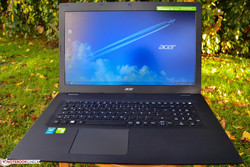
Users who do not have to work outdoors, rarely play games or only use medium settings, and want a good total package with a very good screen will take the Acer Travelmate P277-MG-7474 review sample, perhaps even without an SSD, or one from Acer's Aspire V lineup. The Travelmate P277 offers a brighter screen in the Full HD version than the Aspire V lineup. Then again, the Aspire V line has more attractively prices models that are decent office/multimedia devices with a Full HD screen ("only" 277 cd/m²), Nvidia Geforce 940M and with or without an SSD. For example, Acer's Aspire VN7-792G-52FY Nitro with Nvidia's Geforce 950M for 979 Euros at test time or Acer's Aspire V17 Nitro VN7-792G-55SF with Nvidia's Geforce 945M for 999 Euros at test time. HP's Pavilion 17-g013ng (renamed to HP Pavilion 17-g110ng at test time) for 999 Euros is also a good option although it is louder under load.
Users who want to work outdoors will be happy with the 15.6-inch Asus PU551JH Workstation for 914 Euros or the 17.3-inch Acer Travelmate P277-MG-7474 review sample perhaps without an SSD. The review sample is slow in recharging (small 37 Wh battery, 7 % to 85 %: 1 hour 47 minutes; 7 % to 100 % 2 hours 49 minutes). The touchpad was not fastened properly in the review sample, which is hopefully a single case. The smaller Acer Aspire ES1-420-377F also exhibits considerable touchpad flaws that are very similar with those of our review sample.
Buyers looking for a decent total package and have high demands on gaming quality, should take Acer's Aspire VN7-791G-72Q4 for 1300 Euros (comparable with Acer Aspire V Nitro 7-791G, no longer available).
The manufacturers are very clever at inventing new model names with virtually identical components.
The premium configuration of the review sample does many things right, and the office/multimedia alignment has been followed well. However, when considering the weaknesses that are annoying, the writer hopes for an update in terms of keyboard backlight, better touchpad and larger battery. A good alternative is Asus' PU551JH Workstation. The new edition of Acer's Aspire V VN7 lineup (with and without Nitro) only misses first place due to its screen brightness. 277 cd/m² are not enough for outdoor use (sun, not direct sunlight).
Acer TravelMate P277-MG-7474
- 11/15/2015 v4 (old)
Marcus Conrad




